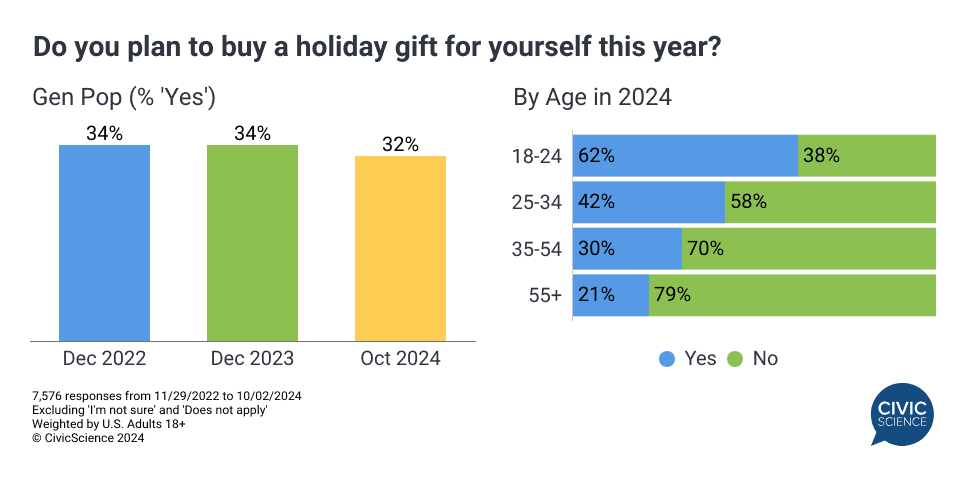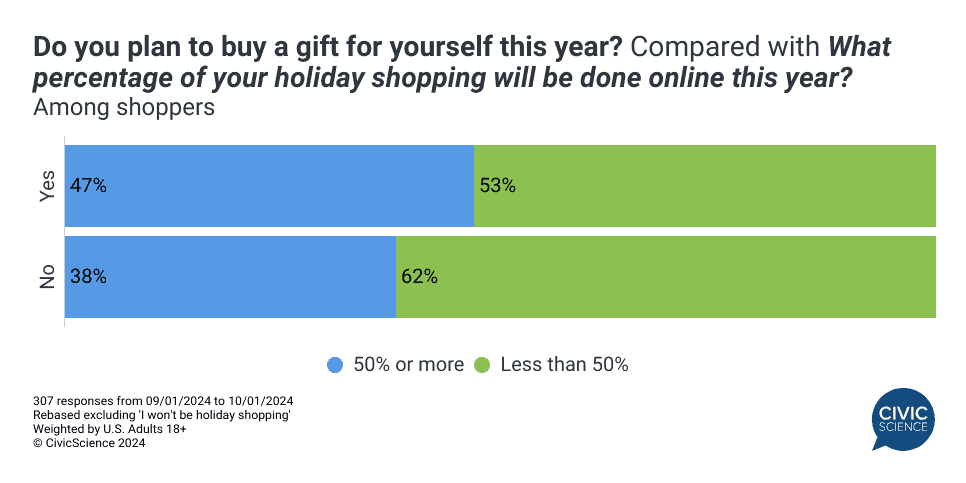This is just a sneak peek at the thousands of consumer insights available to CivicScience clients. Discover more data.
These days, the holiday season isn’t just about giving to others – it might also be about giving to yourself. CivicScience has been following the self-gifting trend for several years, seeing it grow in popularity for both the winter holidays and Valentine’s Day. As we enter into the last quarter of 2024, we’re getting ahead of the holiday shopping season with an early pulse on what self-gifting will look like this year. Here are three key insights about what to expect with holiday self-gifting trends:
1. Self-Gifting Wins Among Gen Z
Currently, 32% of U.S. adults plan to buy themselves a holiday gift (excluding people who are undecided). That’s down two points from December of 2023 and 2022, although it’s still early in the season and many are not sure whether they will buy something or not (21%).
Last year, it was adults aged 25-34 who were the most interested in treating themselves for the holidays, followed by the 18-24 age group. In 2024, Gen Z is the most likely to hop on the self-gifting train, similar to years prior. When broken down by gender, women are more likely than men to participate in the trend.

Join the Conversation: Do you plan on getting gifts for yourself this holiday season?
2. Spending Plans
As the data show, self-gifters are bigger holiday spenders. They plan to spend ‘more’ than ‘less’ this year on the holiday season, while far outpacing those who will not be buying a gift for themselves.

Despite the relatively high percentage of self-gifters who expect to spend more on their holiday shopping, total dollar amount per purchase for personal gifts could be lower this year compared to 2022. Those who plan to spend up to $200 on themselves increased since that time, while those looking to spend more than $200 decreased. The largest percentage (42%) will be spending under $100 on their self-gifting purchases.1
Let Us Know! Do you typically treat yourself during holiday sales?
3. Discount Stores, Specialty Chains, and Online Shopping
As for where they’re spending their money, a strong percentage plan to do most of their gift shopping at big-box retailers (35%), while at the same time that’s significantly less than people not shopping for themselves (43%). This group is almost twice as likely as non-self-gifters to holiday shop at specialty chain stores (10% vs. 6%), such as GAP, Sephora, or Best Buy, prompting these retailers to take notice. They’re also far more likely to shop at deep discount retailers, such as dollar stores (13% vs. 9%).
That said, not everyone will be shopping in person. Self-gifters in particular are the most likely to shop online, with 47% indicating they will do the majority of their shopping online. Online retailers may get an extra boost as these holiday shoppers add a little something extra to their carts.

With so much in flux this year – from the economy to politics and everything in between – it may come as no surprise that self-gifting could look a little different in 2024. Despite the slight drop in self-gifting, the trend remains and has room to grow in the months ahead. It’s especially popular among younger adults with a desire to spend more on holiday shopping overall at a wide variety of businesses.
CivicScience polling unlocks a 360-view of audience insights for publishers, enabling creation of highly engaging content experiences and effective targeting in your advertising strategies. Want to learn more?
- 846 responses from September 30, 2024 to October 2, 2024
↩︎








